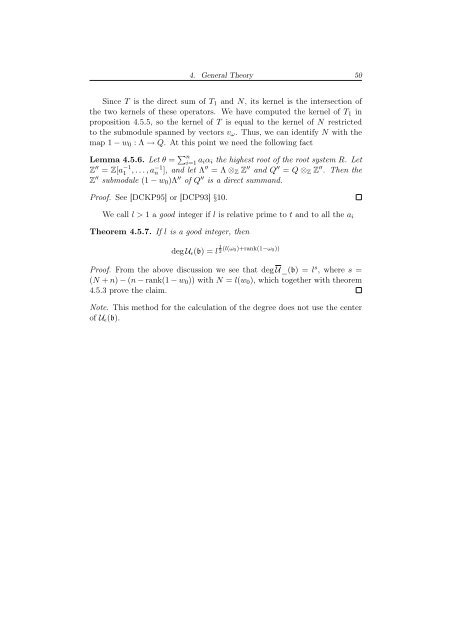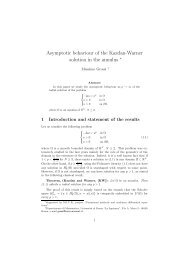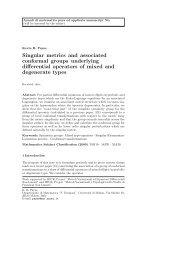Degree of Parabolic Quantum Groups - Dipartimento di Matematica ...
Degree of Parabolic Quantum Groups - Dipartimento di Matematica ...
Degree of Parabolic Quantum Groups - Dipartimento di Matematica ...
You also want an ePaper? Increase the reach of your titles
YUMPU automatically turns print PDFs into web optimized ePapers that Google loves.
4. General Theory 50<br />
Since T is the <strong>di</strong>rect sum <strong>of</strong> T1 and N, its kernel is the intersection <strong>of</strong><br />
the two kernels <strong>of</strong> these operators. We have computed the kernel <strong>of</strong> T1 in<br />
proposition 4.5.5, so the kernel <strong>of</strong> T is equal to the kernel <strong>of</strong> N restricted<br />
to the submodule spanned by vectors vω. Thus, we can identify N with the<br />
map 1 − w0 : Λ → Q. At this point we need the following fact<br />
Lemma 4.5.6. Let θ = n i=1 aiαi the highest root <strong>of</strong> the root system R. Let<br />
Z ′′ = Z[a −1<br />
1 , . . .,a−1 n ], and let Λ ′′ = Λ ⊗Z Z ′′ and Q ′′ = Q ⊗Z Z ′′ . Then the<br />
Z ′′ submodule (1 − w0)Λ ′′ <strong>of</strong> Q ′′ is a <strong>di</strong>rect summand.<br />
Pro<strong>of</strong>. See [DCKP95] or [DCP93] §10.<br />
We call l > 1 a good integer if l is relative prime to t and to all the ai<br />
Theorem 4.5.7. If l is a good integer, then<br />
deg Uǫ(b) = l 1<br />
2 (l(ω0)+rank(1−ω0))<br />
Pro<strong>of</strong>. From the above <strong>di</strong>scussion we see that deg U_(b) = l s , where s =<br />
(N + n) − (n − rank(1 − w0)) with N = l(w0), which together with theorem<br />
4.5.3 prove the claim.<br />
Note. This method for the calculation <strong>of</strong> the degree does not use the center<br />
<strong>of</strong> Uǫ(b).








